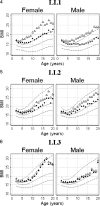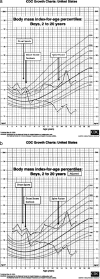Obesity and myelomeningocele: anthropometric measures
- PMID: 21061901
- PMCID: PMC2964030
- DOI: 10.1080/10790268.2010.11689720
Obesity and myelomeningocele: anthropometric measures
Abstract
Objective: To evaluate the appropriate use of arm span measurements as a substitute for height/linear length to evaluate obesity in people with myelomeningocele by comparing calculated body mass indices (BMIs) with recently published BMI graphs by the Centers for Disease Control and Prevention (CDC) and National Center for Health Statistics standards (NCHS) published in 2000.
Study design: Retrospective analysis of collected data on patients seen in the University of Washington Birth Defects Clinic from July 1, 1965, through June 1, 2008. Observations included degree of paralysis, presence of scoliosis, height (linear length), weight, and arm span. We compared published CDC/NCHS BMIs with our data using both height and arm span in place of height/linear length. There were 14,701 measures collected during 4968 visits from 709 patients. Mean values were calculated using age, gender, and lesion level as independent variables.
Results: Comparison of BMI means of patients with myelomeningocele suggests that our observations using arm span and height are comparable with the CDC/NCHS BMI means using height for the 2 least paralyzed groups but not for those groups with paralysis from high-level lesions that are more likely to exhibit lower extremity deformities or scoliosis.
Conclusions: Published CDC/NCHS graphs, with their percentiles, are appropriate for estimating normal growth by BMI for children born with myelomeningocele when arm span is substituted for length if severe body differences due to high-level paralysis are taken into consideration.
Figures



References
-
- Hayes-Allen MC. Obesity and short stature in children with meningomyelocele. Dev Med Child Neurol. 1972;14(suppl 22):59–64. - PubMed
-
- Charney EB, Rosenblum M, Finegold D. Linear growth in a population of children with meningomyelocele. Zinderchir. 1981;34(4):415–419. - PubMed
-
- Shurtleff DB. Dietary management. In: Shurtleff DB, editor. Myelodysplasias and Exstrophies, Significance, Prevention and Treatment. Orlando, FL: Grune & Stratton; 1986. pp. 285–298.
-
- Roberts D, Shepard RW, Shepard K. Anthropometry and obesity in meningomyelocele. J Pediatr Child Health. 1991;27(2):83–90. - PubMed
-
- Littlewood RA, Trocki O, Shepard RW, Shepard K, Davies PSW. Resting energy expenditure and body composition in children with meningomyelocele. Pediatr Rehabil. 2003;6(1):31–37. - PubMed
MeSH terms
LinkOut - more resources
Full Text Sources
Medical
